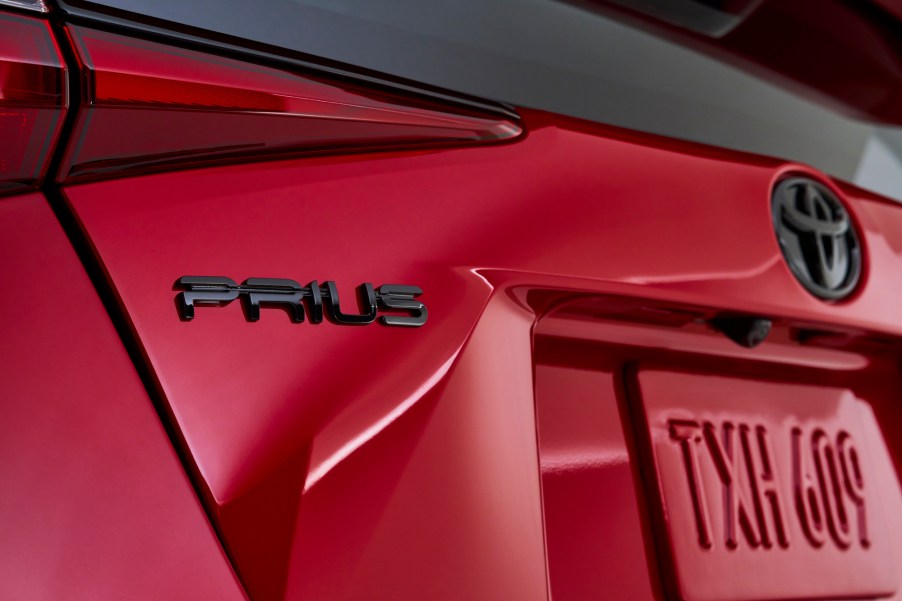
Is the Toyota Prius Prime Better Than the Toyota Prius?
If you’re shopping for a hybrid, chances are you’ve considered a Toyota Prius. It’s one of the most popular hybrids. And if you’re not especially budget-conscious, you might be wondering whether you should purchase a base model or a higher trim. Sometimes, the difference between trim levels isn’t clear, especially when you consider extras, engine choices, and hybrid versions.
For example, the Toyota Prius is a hybrid, while the Toyota Prius Prime is a plug-in hybrid (PHEV). A hybrid’s power comes from a gas engine and an electric motor or motors, while a PHEV uses gas after the electric motor runs out of juice.
So, if you’re considering a Toyota hybrid, what’s the better option, a Toyota Prius or a Prius Prime?
A look at the 2021 Toyota Prius
Though the difference between plug-in hybrids and hybrids may seem minor, it affects multiple aspects of each vehicle. The Toyota Prius and Prius Prime perform and handle differently, and their fuel economy isn’t the same. And while most of their interior amenities are the same or similar, they’re priced differently.
Packing a 1.8-liter four-cylinder engine and one front motor, the Toyota Prius produces 121 hp and 105 lb-ft of torque. It comes standard with front-wheel drive, though you can also opt for an all-wheel-drive e-version that adds a motor in the back. Though the Prius is undoubtedly popular, it’s also not the quickest, taking 9.8 seconds to hit 60 mph. Further, it’s not the most responsive ride and takes longer to brake than similarly sized non-hybrid cars. However, Priuses are well-known for their fuel economy. The regular Prius gets 54/50 mpg city/highway, while the AWD PHEV gets 51/47 MPGe.
The Prius offers decent legroom in the front (42.3 inches) but significantly less in the back (33.4 inches). There’s good cargo space: 27.4 cubic feet behind the rear seats and growing to 50.7 cubic feet with the rear row folded down.
And for a starting price of $24,525, occupants can enjoy a 7.0-inch touchscreen infotainment system with Amazon Alexa, Android Auto, and Apple CarPlay integration. The 2021 Prius also comes standard with a six-speaker sound system, three USB ports, and a Wi-Fi hotspot.
The Toyota Prius Prime at a glance
The Toyota Prius Prime departs from the standard Prius in more ways than the engine and motors. But if you’re looking for a quicker version of the Prius, the Prime isn’t for you. It takes a full 10 seconds to reach 60 mph. However, it’s more fuel-efficient, getting 54/54 MPGe city/highway and allowing you to travel up to 640 miles when fully charged and fueled. The Prius Prime’s powertrain also includes a lithium-ion battery and continuously variable transmission, although it still produces the same horsepower and torque. The lithium-ion battery also makes the car heavier, hampering its handling a bit. Further, the regenerative braking systems found in the Prime can help you brake better but can be challenging for drivers unfamiliar with these systems.
Though the battery helps make the Prius Prime even more efficient, it does so at the expense of some interior space. You’ll get only about 19.8 cubic feet rather than 27.4 cubic feet, but you’ll still be able to fold the rear seats. Interior amenities are the same on the base model, although the Prius Prime’s interior styling looks slightly more upscale than that of the Prius. The Prime also doesn’t come with a Wi-Fi hotspot. For those looking for more, both the Prius and the Prius Prime include 11.6-inch touchscreens, wireless charging, and more advanced safety features.
Standard safety features on both base models include automatic emergency braking, lane-keeping assistance, adaptive cruise control, and lane-departure warning. And you can get other features like blind-spot monitoring on higher trim levels. If you’re considering a base-model Prius Prime, though, you’ll be looking at paying at least $28,220. However, you might be eligible for a tax credit of up to $4,500 if you purchase a Prius Prime.
Which hybrid is better?
The Toyota Prius and Prius Prime differ in some key respects, but they’re the same in many others. Both have the same average reliability ratings, warranty offerings, technology, and safety features. Available cargo space is solid for vehicles in this segment. And though neither handles remarkably well, they offer tremendous fuel efficiency, making them both great values.
In the final analysis, however, the regular Prius offers more cargo room, handles better (thanks to its lighter weight and AWD option), and has slightly better technology in the base model. Though the Prime is the more fuel-efficient option, the Prius edges out the Prime in a head-to-head comparison, U.S. News reports.
Toyota corrects many of the Prius’s shortcomings in higher-level trims. And ultimately, your evaluation of the two will boil down to what you prioritize in a hybrid vehicle.


